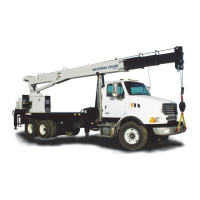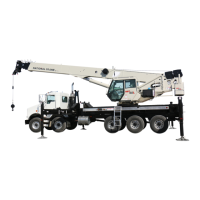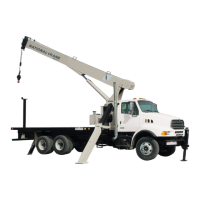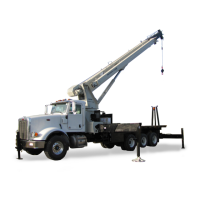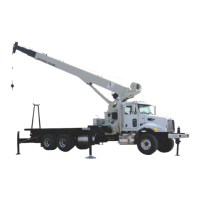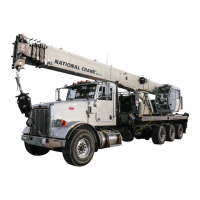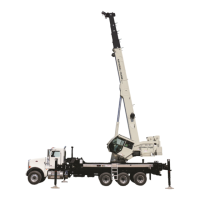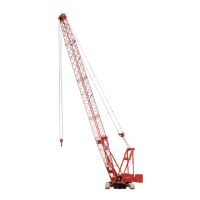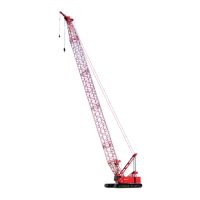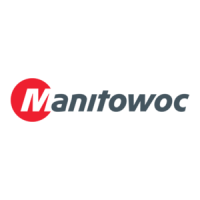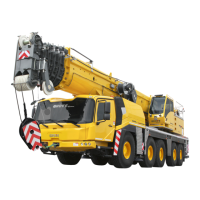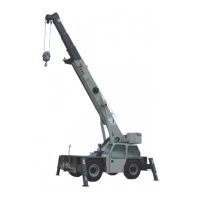2-4 Published 08/16/19 Control # 112-05
HYDRAULIC SYSTEM 500E2 SERVICE MANUAL
• To remove entrapped air from telescope cylinders, lower
the boom to below horizontal and fully telescope the
boom in and out several times.
• If the air is not readily removed, lower the boom to below
horizontal, extend the telescope cylinders as far as
practicable, and allow the boom to remain in this position
overnight. This should allow entrapped air to find its way
to the holding valve so that telescoping the boom IN the
next morning should force the air back to the reservoir.
Ensure the boom is first telescoped IN (not OUT) in the
morning. Telescoping OUT may cause air to be forced
back into the cylinder.
• Entrapped air may be removed from cylinders having
wet rods by cycling. On certain cylinders, a plugged port
is provided on the rod end to bleed off entrapped air.
• In the event that air entrapment should persist, bleeding
of air by loosening various clamp and screw type fittings
may become necessary.
• If the above procedures fail to eliminate air entrapment,
contact your authorized National Crane distributor.
Parts Replacement
Parts found damaged or out of tolerance when maintenance
is being performed should be replaced. Refer to the National
Crane Parts Catalog for proper replacement parts.
Maintenance Records
Dated records must be kept for inspection of critical
components such as, brakes, crane hooks, wire ropes,
hydraulic cylinders and relief valve pressure settings. These
records must be kept where they can be easily obtained and
reviewed.
Hydraulic Oil Reservoir
The hydraulic oil reservoir has a sight gauge located on the
side of the reservoir. This sight gauge has a decal beside it
that indicates a “full” level and an “add oil” level. The oil
required to bring it from the “add” line to the “full” line is 5
gallons. Do not fill the reservoir above the “full” line. The oil
level should be checked with the crane parked on a level
surface, in the transport condition (all cylinders retracted and
boom stowed) and the oil cold.
Hydraulic Filter
Return oil filtration has been designed to handle the
maximum system flow and to protect the hydraulic system
components.
The filter is mounted on the oil reservoir, and is a replaceable
canister type return oil filter. The filter must be serviced with
National Crane replacement elements at recommended
intervals to assure the warranty remains in force.
Oil Cooler Service & Maintenance (Optional)
The heat exchanger must be kept clean to allow for efficient
operation of the cooler system. Frequent washing of the heat
exchanger core will eliminate oil film, road dirt and other
foreign object buildup on the heat exchanger fins which
reduces cooling efficiency.
Frequent inspection and tightening of hose clamp line
connections will eliminate the possibility of end connection
failure due to back pressure from cold startup.
If cooler system fails to provide adequate performance,
reduced air or oil flow through the heat exchanger is the
probable cause. The cooling fan should be inspected for
proper operation. Any obstructions to air flow should be
CAUTION
Always locate the machine on a firm supporting surface,
extend the outriggers and level the machine and position
the boom over the front to extend the boom at low angles.
Injury or damage to the machine may result if this caution
is not followed.
CAUTION
Do not attempt to loosen fittings in pressurized lines or
while the hydraulic pumps are in operation.
Extreme care must be used when removing any plugs or
restrictions from a hydraulic system suspected to have
entrapped air that may be pressurized. Moderate to minor
injury may result from pressurized air in a hydraulic
system.

